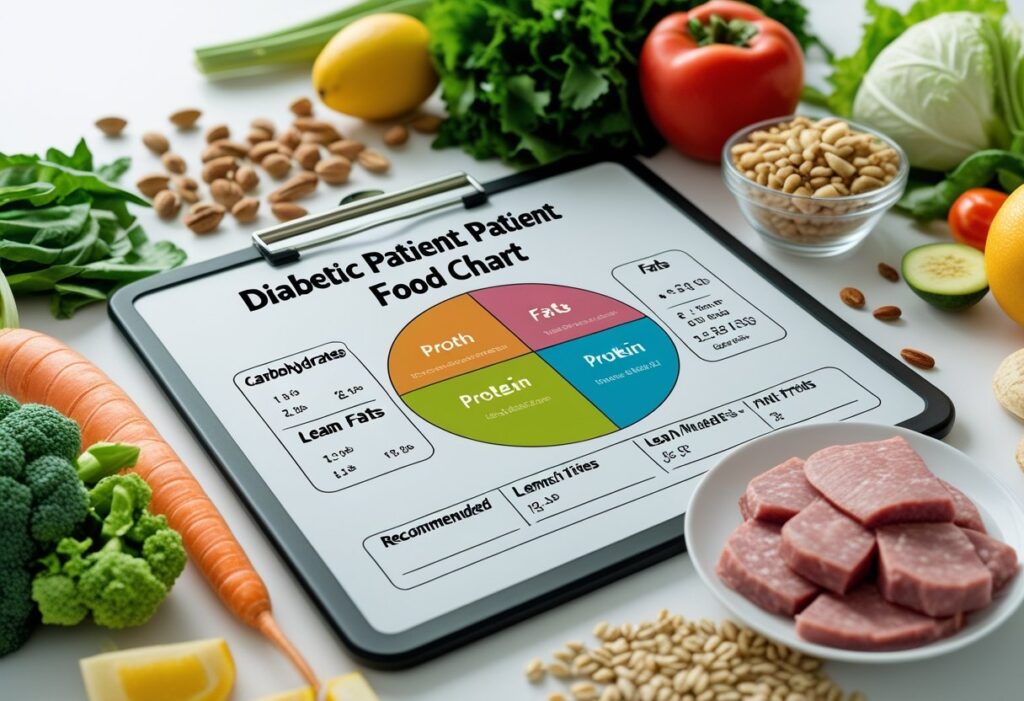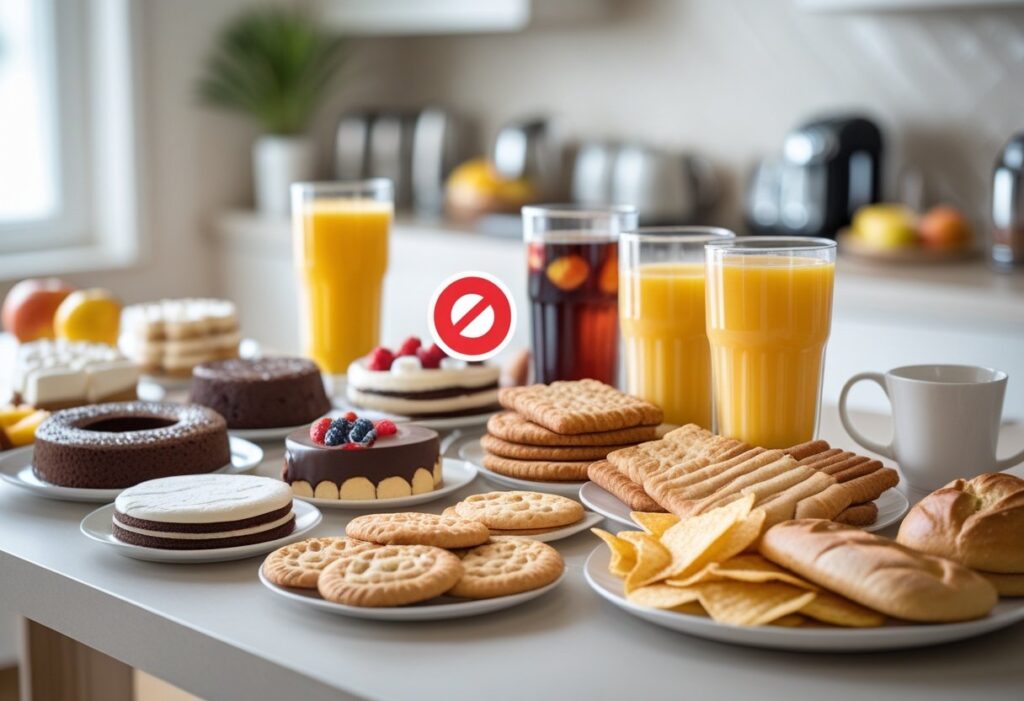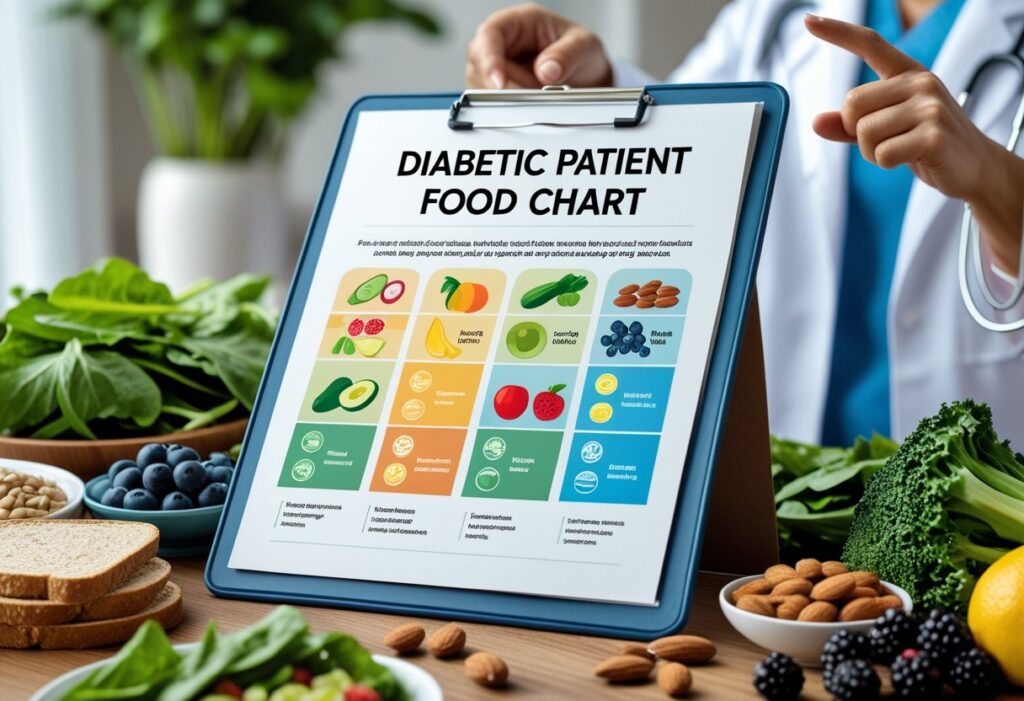Managing diabetes starts with choosing the right foods every day. A diabetic patient food chart helps organize meals to keep blood sugar stable and provide balanced nutrition. It shows which foods to eat more often, which ones to limit, and how to control portion sizes for better health.
This chart usually includes plenty of nonstarchy vegetables, whole grains, lean proteins, and healthy fats. It also highlights foods to avoid or reduce, like those high in added sugars and refined grains. Following a clear food chart can make meal planning easier and support long-term diabetes management.
Personalizing the food chart based on individual needs and preferences is important. A well-planned diet can improve energy, control weight, and lower the risk of complications. Understanding how to build and use this chart helps people with diabetes stay on track with their health goals.
Key Takeaways
- A diabetic food chart guides healthy meal choices to manage blood sugar.
- It emphasizes balanced portions of vegetables, proteins, and whole grains.
- Customizing the chart helps meet personal health needs and improves lifestyle.
Understanding Diabetes and Nutritional Needs
Diabetes affects how the body handles blood sugar, requiring careful management of food choices. Knowing the types of diabetes and the role of nutrition helps in planning a diet that keeps blood sugar steady and supports overall health.
Types of Diabetes
Diabetes mainly includes two types: type 1 and type 2.
Type 1 diabetes happens when the body stops making insulin, a hormone that helps sugar enter cells. It often begins in childhood or young adulthood. People with type 1 need insulin injections every day.
Type 2 diabetes is more common and happens when the body does not use insulin well. It is often linked to being overweight and can develop over time, especially in adults. Prediabetes is a condition where blood sugar is higher than normal but not high enough for a diabetes diagnosis. It raises the risk of developing type 2 diabetes.
Both types require monitoring blood sugar and following a healthy diet to avoid complications.
Role of Nutrition in Diabetes Management
Nutrition is key to managing diabetes. It helps control blood sugar, supports weight management, and reduces risks of heart disease.
Eating balanced meals with correct portions of carbohydrates, proteins, and fats helps prevent blood sugar spikes. Carbohydrates directly affect blood sugar, so tracking them is essential.
Healthy fats and lean proteins support heart health and keep the body full longer. Fiber-rich foods, such as vegetables and whole grains, slow digestion and help control blood sugar.
Regular meal times and portion control improve consistency in blood sugar levels.
Guidelines for a Diabetic Diet

Following clear dietary guidelines helps diabetic patients eat well and manage their condition.
Key points include:
- Carbohydrate control: Use the Diabetes Plate method, filling half the plate with non-starchy vegetables, one-quarter with lean protein, and one-quarter with whole grains or starchy vegetables.
- Limit added sugars and refined carbs such as sweets, sugary drinks, and white bread.
- Choose healthy fats like nuts, seeds, and olive oil, while avoiding trans fats.
- Include fiber-rich foods like beans, fruits, and whole grains.
- Stay hydrated and limit sugary drinks.
These recommendations align with the Dietary Guidelines for Americans, which focus on nutrient-dense foods and balanced meals to support blood sugar stability and overall health (CDC Diabetes Meal Planning).
Core Components of a Diabetic Patient Food Chart

A diabetic food chart helps guide the selection and portion sizes of foods to manage blood sugar effectively. It focuses on balancing carbohydrates, proteins, and fats to control glucose levels while providing necessary nutrition.
Carbohydrate Management and Carb Counting
Carbohydrates directly affect blood glucose, so managing their intake is essential. A diabetic patient should understand how to count carbs, aiming for consistent portion sizes to avoid spikes in blood sugar. Complex carbohydrates, like whole grains and vegetables, are preferred over simple sugars because they contain more fiber, which slows glucose absorption.
A typical meal plan divides carbohydrates evenly through the day. The list of foods in a diabetic chart often shows the carbohydrate content, usually in 15-gram portions, to help with accurate carb counting. Monitoring carb intake helps maintain stable blood glucose levels and supports balanced meals source.
Protein and Lean Protein Choices
Proteins are key for tissue repair and muscle health and cause little change in blood sugar. Diabetic meal plans include lean protein sources to reduce saturated fat intake. Examples are skinless poultry, fish, legumes, and low-fat dairy.
Protein should be included in every meal to maintain fullness and balance blood sugar after eating carbohydrates. Plant-based proteins like beans and lentils offer fiber too, which benefits glucose control. Portion sizes matter to avoid excess calories or fat, making choice and amount important for managing weight and heart health source.
Importance of Healthy Fats
Healthy fats support heart health and can improve blood sugar control when used properly. Sources include nuts, seeds, olive oil, and fatty fish. These fats are unsaturated and can replace saturated and trans fats, which harm cholesterol levels.
Including moderate amounts of healthy fats in meals helps with nutrient absorption and provides lasting energy. However, portion sizes should be controlled because fats are calorie-dense. Avoid fried foods and processed snacks high in unhealthy fats to maintain a balanced meal plan. This approach supports both diabetes management and cardiovascular health source.
Best Foods for Diabetic Patients
Choosing foods that stabilize blood sugar and provide essential nutrients is critical. The right mix of fruits, vegetables, grains, dairy, and snacks supports steady energy and overall health.
Fruits and Fruit Choices
Fruits offer vitamins and fiber but vary in sugar content. Fresh fruits like apples, pears, berries (blackberries, blueberries, raspberries, strawberries), and cherries have lower glycemic indexes. These are better choices for managing blood sugar than higher-sugar options like bananas, grapes, and watermelon.
Whole or fresh fruits are preferable to canned fruit, which often contains added sugars. Portion size matters; a small apple or a half-cup of berries provides nutrients without spiking blood sugar.
Including avocado benefits heart health and blood sugar control due to its healthy fats. Oranges and plums can be eaten in moderation as part of balanced meals.
Vegetables: Nonstarchy and Starchy Options
Nonstarchy vegetables such as broccoli, spinach, kale, collard greens, and green beans are important for fiber and nutrients. These vegetables have minimal impact on blood glucose.
Starchy vegetables include potatoes, corn, peas, and winter squash. These raise blood sugar more and should be eaten in smaller portions. Balancing these with protein or healthy fat slows glucose absorption.
In general, increasing nonstarchy vegetables supports better blood sugar control. Sauteed greens or steamed broccoli are simple, healthy choices that fit well in any meal plan.
Whole Grains and Low-Fat Dairy
Whole grains like brown rice, quinoa, whole wheat bread, and oats digest slower, which helps prevent blood sugar spikes. They contain fiber, vitamins, and minerals important for health.
Refined grains like white bread and white rice should be limited because they raise blood sugar quickly.
Low-fat dairy products, including Greek yogurt and skim milk, provide protein and calcium with fewer calories and less saturated fat. Greek yogurt also offers probiotics, which may support digestion. Choosing unsweetened options avoids extra sugars.
Healthy Snacks and Desserts
Smart snack choices can help manage hunger and blood sugar. Nuts, such as almonds and walnuts, deliver healthy fats and protein without added carbs.
For desserts, fresh fruit or small portions of berries are better options than sugary treats. Pair fruit with a protein like cottage cheese to reduce blood sugar impact.
Low-sugar snacks like whole grain crackers or popcorn in moderate amounts can fit into a diabetic meal plan. Avoid snacks high in refined sugars and saturated fats.
Using a detailed diabetic food chart helps plan meals with the right balance of these foods.
Foods to Limit or Avoid with Diabetes

People with diabetes need to watch certain foods that can cause blood sugar to rise quickly or make managing the condition harder. These include items high in added sugars, processed ingredients, unhealthy fats, and salt. Knowing what to avoid helps keep blood sugar stable and supports overall health.
Added Sugars and Sugary Foods
Foods with added sugars can cause rapid blood sugar spikes. This includes candy, pastries, and many desserts. Reading food labels is important because added sugars appear under many names like corn syrup, sucrose, or fructose.
Sugary snacks and sweets offer little nutrition and can worsen blood sugar control. People with diabetes should limit or avoid items like:
- Candy bars
- Cookies
- Cakes
- Sweetened breakfast cereals
Choosing natural sources of sweetness, like whole fruits, is better. These contain fiber, which slows sugar absorption.
Processed Foods and Refined Carbs
Processed foods often contain refined carbohydrates that break down quickly into sugar. Examples include white bread, crackers, and many snack foods. These can cause blood sugar to rise fast.
Refined carbs lack fiber and important nutrients. Eating whole grains, beans, and vegetables instead can improve blood sugar control. It also helps to scan food labels for words like “refined flour” or “enriched wheat,” which indicate less healthy options.
Highly processed snacks such as chips and packaged pastries should be limited. They often contain unhealthy fats and added sugars as well.
High-Sodium and Fatty Foods
Eating too much salt and unhealthy fats can increase the risk of heart disease, which is already higher in people with diabetes. Foods high in saturated and trans fats, like fried foods and fatty meats, should be avoided.
Salt intake should be reduced by limiting processed and packaged foods. This helps control blood pressure and protects the heart.
Examples of foods to limit:
- Fried fast food
- Bacon and sausage
- Packaged salty snacks
- Butter and cream-based sauces
Opting for healthier fats like olive oil and nuts supports better heart health.
Beverages and Sweets
Sugary drinks like soda, energy drinks, and sweetened coffee or tea add a lot of sugar quickly without filling hunger. These beverages raise blood sugar fast and offer no nutritional benefit.
Many fruit juices also contain added sugars or lose their fiber during processing, making them less ideal.
Other sweets to avoid include ice cream and sweetened yogurt, which may have added sugars.
Water, unsweetened tea, and coffee are safer drink choices. When buying sweetened products, checking food labels for sugar content helps make better decisions.
Sample Diabetic Food Charts and Meal Plans
A good diabetic food chart helps people create balanced meals with the right portions of vegetables, proteins, and carbs. Different meal plans fit different calorie needs and lifestyles, making it easier to manage blood sugar levels.
Diabetes Plate Method
The Diabetes Plate Method is a simple way to control food portions without counting calories. Half the plate is filled with nonstarchy vegetables like leafy greens, broccoli, or peppers. One quarter of the plate holds lean protein sources such as chicken, fish, or beans. The last quarter contains carbohydrates like whole grains or starchy vegetables.
Adding a small serving of fruit or dairy on the side is also recommended. This method supports consistent blood sugar management and easy meal planning. Its visual format helps people quickly build healthy meals without complex measurements. More details on this method can be found through resources on the Diabetes Plate Method.
1,500-Calorie Meal Plan Example
A 1,500-calorie diabetes meal plan balances carbs, proteins, and fats throughout the day. Breakfast might include oatmeal with berries and a boiled egg. Lunch could be a salad with mixed greens, grilled chicken, and a small serving of quinoa. Dinner often features steamed veggies, a lean protein, and a small portion of brown rice.
Snacks between meals include options like nuts, yogurt, or fresh fruit. This eating plan helps maintain steady blood sugar and supports weight control. It’s designed to fit general needs but may require adjustment based on individual activity levels and health status. More sample plans can be seen in a 7-day meal plan.
Flexible Meal Plans for Different Needs
Meal plans for diabetes can vary widely. Some people may need lower calorie plans, while others might require more carbs due to high activity. Flexibility is key to matching lifestyles and personal preferences.
Using tools like laminated meal planners or printable food charts can simplify organizing meals. This allows users to swap foods that fit the same category, such as replacing chicken with tofu or broccoli with green beans, according to taste or availability. Nutritionists often recommend adjusting portion sizes and food choices to match blood sugar targets and calorie needs. For practical tools, a diabetic meal planner can help with planning.
Lifestyle Considerations for Diabetic Patients
A diabetic patient needs to balance daily habits carefully to support blood sugar control and overall health. This involves keeping active, drinking enough fluids, watching blood sugar changes, and managing portion sizes.
Regular Exercise and Strength Training
Regular exercise helps improve insulin sensitivity, allowing the body to use blood sugar more effectively. Both aerobic activities, like walking or cycling, and strength training are important. Strength training builds muscle, which can help burn glucose even when resting.
It is recommended to aim for at least 150 minutes of moderate exercise each week, spread over several days. This routine helps lower the risk of heart disease, which people with diabetes face at higher rates.
Before starting a new exercise program, patients should check blood sugar levels and adjust medication if needed. Consistency is key to seeing lasting benefits in blood sugar control and overall fitness.
Importance of Hydration
Staying hydrated supports blood sugar regulation and overall body function. Dehydration can cause blood sugar levels to rise, making it harder to manage diabetes.
Water is the best choice for hydration. Sugary drinks and sodas can spike blood sugar and should be avoided. Drinking enough water helps keep kidneys healthy by flushing out excess glucose through urine.
A general guideline is to drink about 8 cups of water per day but this can vary based on activity level, climate, and health status. Drinking regularly throughout the day is best, rather than waiting until thirsty.
Managing Blood Sugar Levels
Managing blood sugar requires frequent monitoring and understanding how food, activity, and medication affect levels. Checking glucose before and after meals or exercise gives important feedback.
Patients should work with their healthcare providers to set target blood sugar ranges and adjust insulin or other medications accordingly. Skipping meals or overindulging in carbohydrates can cause blood sugar swings.
Keeping a log of blood sugar readings helps track patterns. This information is useful for managing diet and medication effectively and preventing complications from high or low sugar levels.
Portion Control and Weight Management
Portion control is crucial for keeping blood sugar stable and supporting weight loss or maintenance. Eating large portions, especially of carbs, can raise glucose quickly.
Using a diabetes meal plan with controlled servings of nonstarchy vegetables, lean proteins, and healthy fats helps balance meals. The “Diabetes Plate” method divides the plate into half vegetables, a quarter proteins, and a quarter carbohydrates to guide portion sizes.
Losing excess weight through diet and exercise improves insulin sensitivity and reduces the risk of heart disease. Tracking portion sizes and calories support these goals without drastic dieting.
Planning and Personalizing a Diabetic Food Chart

Creating an effective diabetic food chart requires attention to individual needs, lifestyle, and health goals. Personalization helps manage blood sugar levels while ensuring proper nutrition. The process involves expert advice and ongoing monitoring to adjust the plan as needed.
Role of Registered Dietitians and Professional Guidance
Registered dietitians play a key role in developing a personalized food chart for diabetic patients. They assess medical history, activity level, and blood sugar control to create an eating plan suited to each person. Dietitians recommend specific food types, portion sizes, and meal timing to maintain steady glucose levels.
They focus on balancing carbohydrates, proteins, and fats while including fiber-rich foods. Their guidance helps avoid blood sugar spikes or drops. Dietitians also provide education on reading food labels and making healthier choices. Working with a professional ensures the plan fits lifestyle preferences and medical needs.
Monitoring Progress and Adjustments
Regular monitoring of blood sugar and diet results is essential for effective diabetes management. Patients may track their glucose levels, food intake, and symptoms to identify patterns. Based on this data, dietitians can adjust the food chart by changing portion sizes, food choices, or meal timing.
Adjustments help improve blood sugar control, prevent complications, and support long-term health. It is important to review progress frequently, especially after lifestyle changes or medication updates. Monitoring also helps identify any concerns early and promotes accountability in managing diabetes.
Frequently Asked Questions
Managing diabetes requires careful food choices, meal timing, and portion control. Knowing which foods to eat, avoid, and how to plan meals can help control blood sugar effectively.
What are the recommended foods for a diabetic meal plan?
Foods high in fiber like vegetables, whole grains, and legumes are recommended. Lean proteins such as chicken, fish, and tofu help maintain energy without raising blood sugar.
Fruits low in sugar, nuts, and healthy fats like olive oil are also good choices. Portion control is important to avoid spikes in blood glucose.
How can a 7-day diabetic meal plan help manage blood sugar levels?
A 7-day plan provides structure, helping to balance carbs, proteins, and fats consistently. It prevents large swings in blood sugar by encouraging regular meals and snacks.
This plan also allows careful monitoring of carbohydrate intake, which is key for blood sugar control. It can reduce guesswork and improve meal variety.
Which foods should be avoided in a diabetes diet sheet?
Sugary drinks, sweets, and processed foods high in refined carbs should be avoided. These cause rapid blood sugar spikes.
Fried foods and high-fat processed meats can increase the risk of heart disease. Limit white bread, white rice, and snacks with added sugars.
What constitutes a balanced diet for type 2 diabetes management?
A balanced diet includes a mix of vegetables, lean proteins, whole grains, and healthy fats. Controlling carbohydrate intake is essential to avoid blood sugar spikes.
Meals should be spaced evenly, and portion sizes kept moderate. Fiber-rich foods help slow glucose absorption and improve blood sugar levels.
How can a diabetic patient plan meals for a whole month?
They can start by creating a list of approved foods and recipes suitable for diabetes. Group meals by type (breakfast, lunch, dinner) and repeat favorites with variation.
Using a meal planner or calendar helps ensure consistent carb intake and balanced nutrition. Preparing meals ahead saves time and supports meal control.
What are some simple meal planning tips for someone with diabetes?
Plan meals around non-starchy vegetables and lean proteins first. Use measuring cups or a food scale to keep portions correct.
Include snacks to avoid overeating at main meals. Drink plenty of water and avoid skipping meals to maintain steady blood sugar.
For more detailed guidance, see diabetes meal planning advice from the Mayo Clinic.




Pingback: Diabetes Prediction Using Machine Learning: Models, Data, and Accuracy - Pharma Heals
Pingback: Overnight Oats for Diabetes: How This Simple Breakfast Can Help Stabilize Your Blood Sugar Levels - Pharma Heals